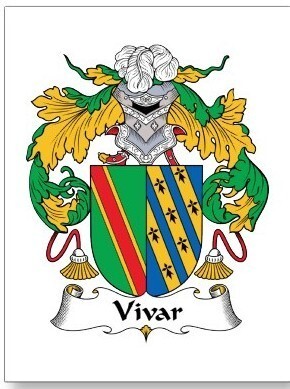Families Klein, Ree, de Breed en de Vries van Terschelling » Rodrigo Díaz (el Cid) de Vivar (1043-1099)
Persoonlijke gegevens Rodrigo Díaz (el Cid) de Vivar
Bron 1- Hij is geboren in het jaar 1043 in Burgos, Burgos, Castilla-Leon, Spain.
- Hij is overleden op 10 juli 1099 in Valencia, Valencia, Pais Valenciano, Spain ( 56 años), hij was toen 56 jaar oud.
- Een kind van Diego Lainez de Castro en Teresa Nunez de Amaya de Castro
Gezin van Rodrigo Díaz (el Cid) de Vivar
Hij is getrouwd met Jimena Diaz de Oviedo y Asturias.
Zij zijn getrouwd.
Kind(eren):
- Diego Rodriguez Vivar 1076-1097
- Christina Rodriguez Diaz de Vivar 1077-1116
Notities over Rodrigo Díaz (el Cid) de Vivar
Rodrigo Díaz de Vivar, nació en esta localidad a siete kilómetros al norte de la ciudad de Burgos en 1040 (otros dicen 1043), era hijo de Diego Laínez y de una hija de Rodrigo Álvarez,- era el Alférez Real de Castilla de AlfonsoVI de Castilla.
Biografía
Rodrigo Díaz de Vivar (1043–1099) was a Castilian nobleman and military leader in medieval Spain. He was called El Cid (the Lord) by the Moors and El Campeador (the Champion) by Christians. He is the national hero of Spain.
Born a member of the minor nobility, El Cid was brought up at the court of the Spanish Emperor Ferdinand the Great and served in the household of Prince Sancho. He rose to become commander and the royal standard-bearer (armiger regis) of Castile upon Sancho's ascension in 1065. He went on to lead the Castilian military campaigns against Sancho's brothers, the rulers of the kingdoms of Leon and Galicia as well as against the Muslim kingdoms in Andalusia. He became famous for his military prowess in these campaigns and helped enlarge Castilian territory at the expense of the Muslims while driving Sancho's brothers from their thrones. This, however, ended up putting him in a difficult position when, in 1072, Sancho died suddenly without issue, leaving his brother, Alfonso, as his only heir and ruler of the reunified empire. Although El Cid continued to serve the crown in the person of Alfonso, who was now Emperor of Spain, he lost his status in court and was held in suspicion. Finally, in 1081, he was ordered into exile.
Rodrigo Díaz found work fighting for the Muslim rulers of Zaragoza, whom he protected from the domination of Aragon and Barcelona, further bolstering his military record and reputation as a leader. He was also victorious in battles against the Muslim rulers of Lérida and their Christian allies, as well as against a large Christian army under King Sancho Ramírez of Aragon. In 1086, Alfonso was defeated by Almoravids from North Africa, and he overcame his antagonism to talk de Vivar into fighting for him again. Over the next several years El Cid set his sights on the kingdom-city of Valencia, operating more or less independently of Alfonso while politically supporting the Banu Hud and other Muslim dynasties opposed to the Almoravids. He gradually increased his control over Valencia; the Muslim ruler, al-Qadir, became his tributary in 1092. However, the Almoravids instigated an uprising that resulted in the death of al-Qadir - he responded by laying siege to the city. Valencia finally fell in 1094 and El Cid established an independent principality in the eastern Mediterranean coast of Spain. He ruled over a pluralistic state with the popular support of both Christians and Muslims.
The final years of El Cid were spent in fighting the Almoravid Berbers. He inflicted the first major defeat on them in 1094 in the plains of Caurte outside Valencia and continued resisting them until his death. Although El Cid himself remained undefeated in Valencia, he suffered a tragedy when his only son and heir, Diego Rodríguez, died fighting against the Almoravids in the service of Alfonso in 1097. After the Cid's death in 1099, his wife Jimena Díaz, succeeded him as ruler of Valencia, but she had to surrender the principality to the Almoravids in 1102.
Long after his death, El Cid remains an idealised figure in Spain. He has been immortalized in plays, film, folk tales and songs
Tijdbalk Rodrigo Díaz (el Cid) de Vivar
 grootouders
grootouders
 ouders
ouders
 broers/zussen
broers/zussen
 kinderen
kinderen
Voorouders (en nakomelingen) van Rodrigo Díaz (el Cid) de Vivar
Rodrigo Díaz (el Cid) de Vivar  | |||||||||||||||||||||||||||||||||||||
Jimena Diaz de Oviedo y Asturias | |||||||||||||||||||||||||||||||||||||
Bronnen
- Del Castillo Ortiz Web Site, Marcos Antonio Del Castillo Ortiz, Rodrigo D�az de Vivar, "EL Cid Campeador", 26 februari 2015
Added by confirming a Smart Match
MyHeritage.com family tree Family site: Del Castillo Ortiz Web Site Family tree: FAMILIA DEL CASTILLO ORTIZ
Aanknopingspunten in andere publicaties
Deze persoon komt ook voor in de publicatie:Dezelfde geboorte/sterftedag
- 1099 » El Cid (±59), Spaans ridder
- 1480 » René I van Anjou (71), koning van Napels
- 1559 » Hendrik II (40), Frans koning
- 1584 » Francis Throckmorton (±30), Engels samenzweerder
- 1584 » Willem van Oranje (Willem de Zwijger) (51), Nederlands stadhouder
- 983 » Benedictus VII, paus van 974 tot 983
Over de familienaam De Vivar
- Bekijk de informatie die Genealogie Online heeft over de familienaam De Vivar.
- Bekijk de informatie die Open Archieven heeft over De Vivar.
- Bekijk in het Wie (onder)zoekt wie? register wie de familienaam De Vivar (onder)zoekt.
Marthan Klein, "Families Klein, Ree, de Breed en de Vries van Terschelling", database, Genealogie Online (https://www.genealogieonline.nl/families-klein-ree-ea/I42756.php : benaderd 3 mei 2024), "Rodrigo Díaz (el Cid) de Vivar (1043-1099)".


